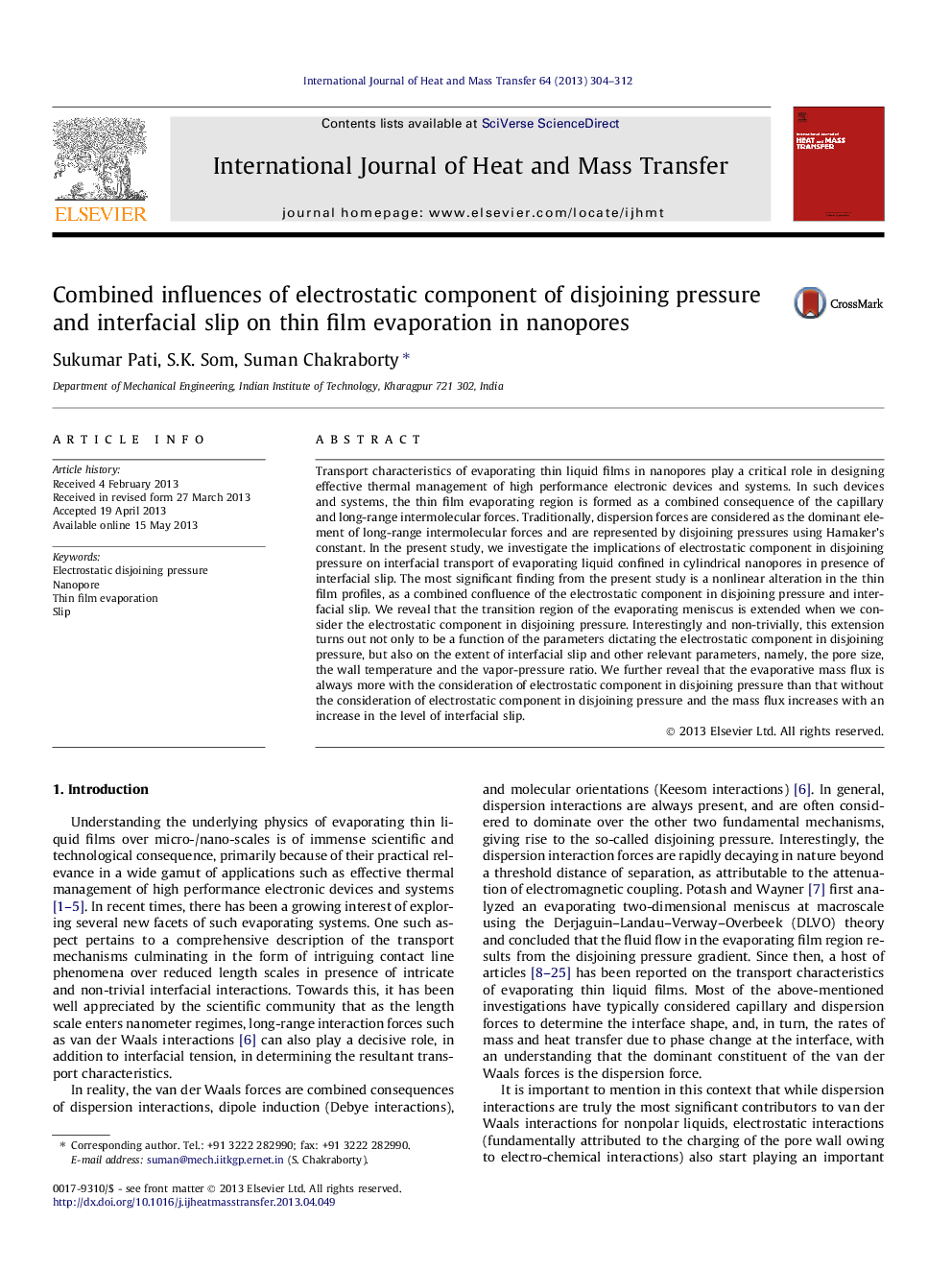| کد مقاله | کد نشریه | سال انتشار | مقاله انگلیسی | نسخه تمام متن |
|---|---|---|---|---|
| 7058699 | 1458078 | 2013 | 9 صفحه PDF | دانلود رایگان |
عنوان انگلیسی مقاله ISI
Combined influences of electrostatic component of disjoining pressure and interfacial slip on thin film evaporation in nanopores
ترجمه فارسی عنوان
تأثیرات ترکیبی مولکول الکترواستاتیک فشار ناشیانه و لغزش بین فاز در تبخیر نازک فیلم در نانوپورها
دانلود مقاله + سفارش ترجمه
دانلود مقاله ISI انگلیسی
رایگان برای ایرانیان
کلمات کلیدی
فشار نامنظم الکترواستاتیک، نانوپور، تبخیر فیلم نازک، لیز خوردن،
ترجمه چکیده
ویژگی های حمل و نقل تبخیر فیلم های نازک مایع در نانوپور ها نقش مهمی در طراحی مدیریت موثر حرارتی دستگاه های الکترونیکی و سیستم های با کارایی بالا دارند. در چنین دستگاه ها و سیستم ها، ناحیه تبخیر نازک فیلم به عنوان یک نتیجه ترکیبی از نیروهای بین مولکولی مویرگی و طولانی مدت تشکیل شده است. به طور سنتی، نیروهای پراکندگی به عنوان عنصر غالب نیروهای بین مولکولی طولانی مدت در نظر گرفته می شوند و با استفاده از ثابت های همیکر با فشارهای ناخواسته نشان داده می شوند. در مطالعه حاضر، ما در بررسی اثرات مولکول الکترواستاتیک در فشار ناشی از انتقال مفاصل مایع تبخیر شده محدود شده در نانوپانهای استوانه ای در حضور لغزش فضایی بررسی شده است. مهمترین یافته های تحقیق حاضر، یک تغییر غیرخطی در پروفیل های فیلم نازک، به عنوان ترکیبی ترکیبی از اجزای الکترواستاتیک در لغزش ناشی از فشار و یکنواختی است. ما نشان می دهیم که منطقه انتقال منیسک تبخیری افزایش می یابد، زمانی که مولکول الکترواستاتیک را بدون فشار در نظر بگیریم. جالب توجه و غیر عقلانی، این فرمت نه تنها به عنوان یک پارامتر از پارامترهای تعیین کننده مولکول الکترواستاتیک در فشار مجزا بلکه بر میزان لغزش بین فاز و دیگر پارامترهای مربوطه یعنی اندازه ذرات، دما دیوار و نسبت بخار فشار. علاوه بر این ما نشان می دهیم که جریان شار تبخیری همیشه با توجه به مولفه های الکترواستاتیک در فشار ناشی از آن است که بدون توجه به مولفه های الکترواستاتیک در فشار مجزا و جریان جرم افزایش می یابد با افزایش سطح لغزش بین فضایی.
موضوعات مرتبط
مهندسی و علوم پایه
مهندسی شیمی
جریان سیال و فرایندهای انتقال
چکیده انگلیسی
Transport characteristics of evaporating thin liquid films in nanopores play a critical role in designing effective thermal management of high performance electronic devices and systems. In such devices and systems, the thin film evaporating region is formed as a combined consequence of the capillary and long-range intermolecular forces. Traditionally, dispersion forces are considered as the dominant element of long-range intermolecular forces and are represented by disjoining pressures using Hamaker's constant. In the present study, we investigate the implications of electrostatic component in disjoining pressure on interfacial transport of evaporating liquid confined in cylindrical nanopores in presence of interfacial slip. The most significant finding from the present study is a nonlinear alteration in the thin film profiles, as a combined confluence of the electrostatic component in disjoining pressure and interfacial slip. We reveal that the transition region of the evaporating meniscus is extended when we consider the electrostatic component in disjoining pressure. Interestingly and non-trivially, this extension turns out not only to be a function of the parameters dictating the electrostatic component in disjoining pressure, but also on the extent of interfacial slip and other relevant parameters, namely, the pore size, the wall temperature and the vapor-pressure ratio. We further reveal that the evaporative mass flux is always more with the consideration of electrostatic component in disjoining pressure than that without the consideration of electrostatic component in disjoining pressure and the mass flux increases with an increase in the level of interfacial slip.
ناشر
Database: Elsevier - ScienceDirect (ساینس دایرکت)
Journal: International Journal of Heat and Mass Transfer - Volume 64, September 2013, Pages 304-312
Journal: International Journal of Heat and Mass Transfer - Volume 64, September 2013, Pages 304-312
نویسندگان
Sukumar Pati, S.K. Som, Suman Chakraborty,
